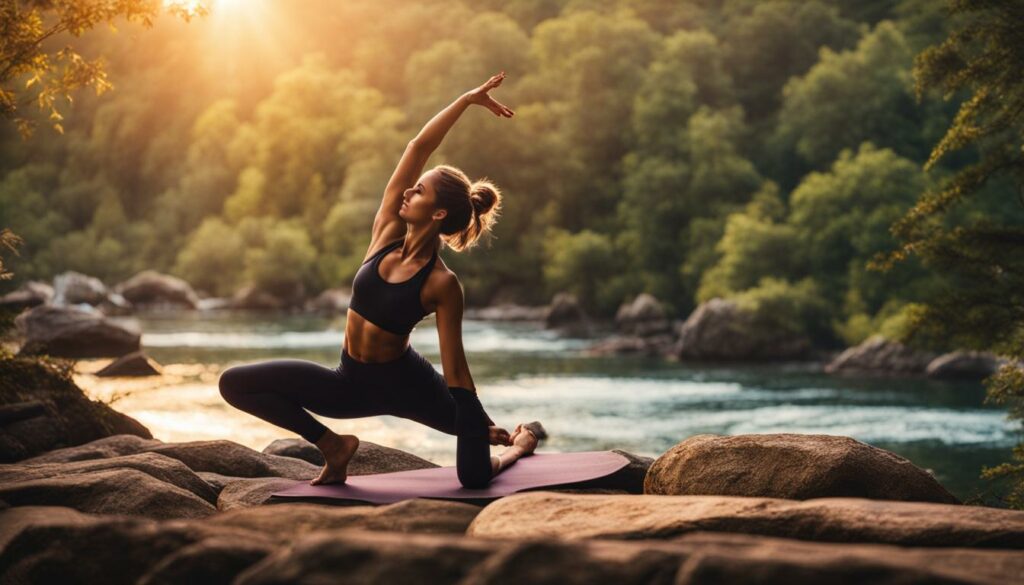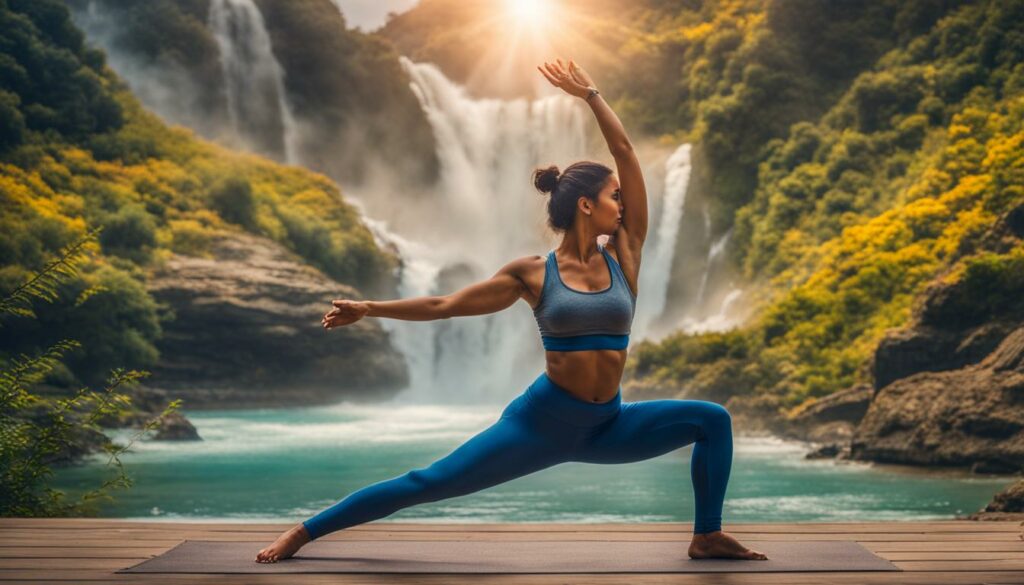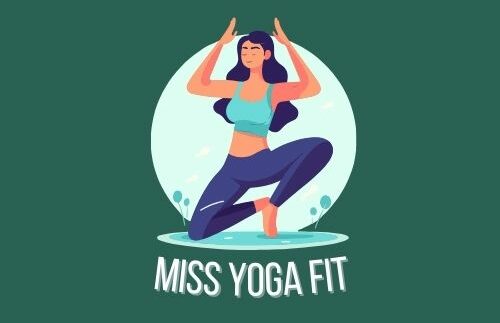If you’re looking for a practice that challenges your body and mind, power yoga might be just what you need. Power yoga is a dynamic style of yoga that combines strength, flexibility, and mindfulness. Unlike traditional yoga, power yoga is physically demanding and requires a level of fitness to perform.

What is Power Yoga
So, what is power yoga exactly? Power yoga is a modern interpretation of Ashtanga yoga, which emphasizes a flowing sequence of postures linked with breath. However, power yoga differs in its approach to sequencing, incorporating a variety of poses to build strength and endurance.
The benefits of power yoga are numerous. Not only does it strengthen and tone muscles, but it also improves flexibility, balance, and coordination. Power yoga also promotes mindfulness, reducing stress and anxiety.
Key Takeaways:
- Power yoga is a dynamic style of yoga that combines strength, flexibility, and mindfulness.
- It is a modern interpretation of Ashtanga yoga, with a focus on sequencing that builds strength and endurance.
- Power yoga strengthens muscles, improves flexibility, balance, and coordination, and promotes mindfulness.
Table of Contents
Power Yoga vs Traditional Yoga
While traditional yoga focuses on slow, controlled movements, power yoga takes a more dynamic approach, combining elements of strength training and flexibility exercises. The practice emphasizes the physical aspects of yoga, making it a popular choice for those seeking a more intense workout.
Compared to traditional yoga, power yoga is typically faster-paced and more challenging, with less emphasis on meditation and breathing techniques. While both practices offer numerous benefits for the mind and body, power yoga is often regarded as a more physically demanding option.
Power Yoga vs Traditional Yoga: A Comparison
| Feature | Power Yoga | Traditional Yoga |
|---|---|---|
| Focus | Physical fitness and strength training | Meditation and spiritual growth |
| Pace | Faster-paced and more intense | Slower-paced and more relaxed |
| Poses | Emphasis on strength and flexibility exercises | Emphasis on holding poses for longer periods of time |
| Breathing | Less emphasis on breathing techniques | More emphasis on breathing and meditation |
Ultimately, the choice between power yoga and traditional yoga comes down to personal preference and fitness goals. While some individuals may prefer the more meditative aspects of traditional yoga, others may find greater satisfaction and physical benefits in the faster-paced, challenging practice of power yoga.
Next, we will explore power yoga for beginners, providing tips and recommendations for those new to this dynamic practice.
Power Yoga for Beginners
If you are new to power yoga, it is important to approach the practice with patience and an open mind. As a dynamic and challenging form of yoga, it may take some time to become comfortable with the various poses and sequences.
There are several tips and recommendations that can help beginners ease into power yoga:
- Start with a basic class: Look for classes specifically geared toward beginners, and let the instructor know that you are new to power yoga so that they can provide additional guidance and modifications as needed.
- Focus on your breath: As with all forms of yoga, the breath is an essential component of power yoga. Focus on deep, intentional breathing as you move through each pose.
- Take breaks as needed: If a pose feels too challenging, don’t hesitate to take a break or come out of the pose entirely. Listen to your body and don’t push yourself too hard too quickly.
- Invest in good equipment: While you don’t need much equipment to practice power yoga, investing in a high-quality mat and comfortable clothing can help make your practice more enjoyable.
Remember that everyone has to start somewhere, and it is okay to make mistakes or struggle with certain poses. With time and practice, you will gradually become more comfortable and confident in your power yoga practice.
Common Power Yoga Poses for Beginners
There are several power yoga poses that are especially beneficial for beginners. Here are a few to get you started:
| Pose Name | Description |
|---|---|
| Downward-facing dog | This pose stretches the hamstrings, calves, and spine while also strengthening the arms and shoulders. |
| Warrior II | This pose strengthens the legs, while stretching the hips and inner thighs. It also helps improve balance and focus. |
| Tree pose | This pose helps improve balance and focus, while also stretching the thighs, groin, and torso. |
Don’t be afraid to modify these poses or take breaks as needed. Remember, your practice is your own, and it is important to listen to your body and honor its limitations.
Power Yoga for Weight Loss
Power yoga is an excellent form of exercise for those looking to lose weight as it provides a full-body workout that targets multiple muscle groups simultaneously. The practice involves intense and dynamic movements that can help burn calories and increase metabolism, allowing for efficient weight loss.
There are several specific power yoga poses that are particularly effective for weight loss, including:
- Chair Pose (Utkatasana) – This pose targets the thighs, buttocks, and hips, helping to tone and strengthen these areas while also increasing heart rate and burning calories.
- Warrior III (Virabhadrasana III) – This pose engages the core, glutes, and legs, providing a full-body workout that can help with weight loss.
- Downward-Facing Dog (Adho Mukha Svanasana) – This pose helps to tone the arms, shoulders, and back while also engaging the core and legs to provide a full-body workout.
Aside from the physical benefits, power yoga also helps with weight loss by reducing stress and promoting overall well-being. Stress can often lead to overeating and weight gain, so by reducing stress levels through the practice of power yoga, individuals can better manage their weight.
Overall, the benefits of power yoga for weight loss are numerous and well-documented. In addition to the specific poses mentioned above, the practice also helps to improve digestion, increase flexibility, and build muscle, all of which contribute to effective and sustainable weight loss.

Power Yoga for Strength and Flexibility
Power yoga is an excellent practice to improve strength and flexibility. The dynamic flow of power yoga incorporates strength-building postures and movements with flexibility-enhancing stretches.
Athletes can benefit from power yoga as it targets key muscle groups used in sports, including the core, hips, and shoulders. By improving strength and flexibility in these areas, athletes can enhance their overall performance and reduce the risk of injury.
Regular power yoga practice also offers a range of other benefits for strength and flexibility, including:
- Increased muscular endurance
- Better balance and coordination
- Improved range of motion
- Greater muscle mass
By incorporating power yoga into your fitness routine regularly, you can improve your strength and flexibility and achieve a more well-rounded level of fitness.
If you are new to power yoga, it’s essential to ease into the practice and not push yourself too hard. Start slowly with beginner-level poses and gradually work your way up to more challenging postures.
Power Yoga Poses for Strength and Flexibility
Here are some power yoga poses that can help improve strength and flexibility:
| Poses | Benefits |
|---|---|
| Downward Facing Dog | Stretches and strengthens the entire body, particularly the hamstrings and shoulders |
| Warrior II | Strengthens the legs, hips, and shoulders while improving balance and stability |
| Tree Pose | Improves balance, stability, and concentration while strengthening the legs and core |
| Chair Pose | Strengthens the legs, hips, and glutes while improving balance and posture |
| Plank | Strengthens the core, arms, and shoulders while improving overall body stability and balance |
Remember to listen to your body and not push yourself too hard. Only do what feels comfortable and safe for you.
By incorporating power yoga into your fitness routine, you can improve your strength and flexibility while reaping a range of other benefits for your mind and body. Whether you are an athlete or just looking to enhance your physical performance, power yoga is an excellent choice.
Power Yoga Flow and Sequence
Power yoga is an intense, physically demanding form of yoga that combines strength and flexibility exercises to form a flowing sequence. The practice is typically performed in a heated studio, which helps warm muscles and increase flexibility. The power yoga sequence is designed to challenge the body and push practitioners to reach their limits.
There are many different power yoga exercises and workouts, each with its unique series of poses. However, most power yoga flow sequences will include some variation of a sun salutation. This is a series of poses that flow together to create a dynamic and energizing workout. The sun salutation is often used as a warm-up for more challenging power yoga poses and sequences.
| Power Yoga Flow Examples | Description |
|---|---|
| Warrior Flow | This flow incorporates warrior poses, which are great for strengthening the legs and core. It also includes lunges, which help improve flexibility and balance. |
| Balance Flow | This flow is designed to improve balance and stability. It focuses on one-legged poses, such as eagle pose, tree pose, and warrior III. Practicing these poses can help improve overall body awareness. |
| Twisting Flow | This flow incorporates twisting poses, such as revolved triangle and revolved chair. Twisting poses are great for improving digestion, detoxifying the body, and improving spinal mobility. |
Power yoga workouts can be customized to fit individual needs and preferences. Some practitioners may prefer a faster-paced, cardio-based workout, while others may focus more on deep stretching and mindful breathing. Regardless of the style, incorporating power yoga into your fitness routine can help improve strength, flexibility, and overall physical performance.
It’s important to note that power yoga can be challenging, especially for beginners. It’s important to start slow and focus on proper alignment and breathing techniques. As your practice progresses, you can gradually increase the intensity and duration of your workouts.
Overall, power yoga is an effective way to improve overall fitness and well-being. Its flowing sequences and challenging poses can help build strength, flexibility, and endurance, while also promoting mindfulness and stress reduction.

Power Yoga Classes and Tips
If you are new to power yoga, attending a power yoga class is an ideal way to get started. In a power yoga class, you will be guided through a series of dynamic sequences tailored to challenge your mind and body.
Here are some tips to help you get the most out of your power yoga class:
- Focus on your breath: Power yoga is a breath-based practice that emphasizes the connection between breath and movement. Try to sync your breath with each movement, inhaling through your nose and exhaling through your mouth.
- Listen to your body: While power yoga is an intense workout, it is crucial to listen to your body and avoid pushing yourself too far. Take breaks whenever necessary and modify poses that feel uncomfortable.
- Stay hydrated: Be sure to drink plenty of water before, during, and after your power yoga class to stay hydrated and energized.
When it comes to finding the right power yoga class, it is essential to consider your experience level and fitness goals. Some studios offer beginner-friendly classes or classes tailored to specific goals, such as power yoga for weight loss or power yoga for athletes.

Alternatives to Power Yoga?
If you feel that this particular yoga style may not align with your current stage in your yoga journey, allow me to introduce you to some alternative yoga styles that I believe will better suit your yoga goals. I encourage you to explore them – they might be just what you’re looking for!
Conclusion
That concludes our in-depth exploration of power yoga. Throughout this article, we have provided a definition of power yoga and highlighted its many benefits. We have also discussed the key differences between power yoga and traditional yoga, as well as tips and recommendations for beginners.
Additionally, we have delved into how power yoga can aid in weight loss, improve strength and flexibility, and benefit both the mind and body. We have provided insights into the flow and sequence of power yoga practice and offered information on power yoga classes and useful tips for practitioners.
Incorporating Power Yoga into Your Fitness Journey
If you’re looking to enhance your fitness journey, we highly recommend trying power yoga. Its dynamic practice offers numerous benefits for both the mind and body, making it a popular choice amongst fitness enthusiasts.
Whether you’re a beginner or an experienced practitioner, power yoga can challenge you, leaving you feeling invigorated and refreshed. Its focus on strength, flexibility, and mindfulness makes it an excellent addition to any fitness routine.
Thank you for joining us on this journey to explore power yoga. We hope this article has provided valuable insights into the practice’s benefits and that you feel inspired to incorporate it into your fitness routine. Namaste!
FAQ
What is Power Yoga?
Power Yoga is a dynamic and energetic form of yoga that combines strength, flexibility, and breath control. It is often characterized by its fast-paced sequences and challenging postures, making it a popular choice for those looking to increase their physical fitness and mental focus.
How does Power Yoga differ from Traditional Yoga?
Power Yoga differs from Traditional Yoga in its emphasis on strength and intensity. While Traditional Yoga focuses on gentle movements and relaxation, Power Yoga incorporates more vigorous and dynamic poses. It is designed to build muscle strength and endurance, making it a great option for those seeking a physical workout.
Is Power Yoga suitable for beginners?
Yes, Power Yoga can be practiced by beginners. However, it is important to start slowly and listen to your body. It is recommended to take beginner-friendly classes or follow guided videos tailored for beginners to gradually build strength and flexibility. Additionally, modifications can be made to poses to accommodate different levels of experience.
Can Power Yoga help with weight loss?
Yes, Power Yoga can aid in weight loss due to its combination of cardiovascular exercise and muscle-building movements. Power Yoga increases heart rate, burns calories, and helps build lean muscle mass, which can contribute to weight loss over time. Additionally, the practice promotes overall physical fitness and body awareness.
How does Power Yoga improve strength and flexibility?
Power Yoga incorporates a variety of poses that target different muscle groups, helping to improve overall strength and flexibility. The dynamic movements and holds challenge the body, promoting muscular endurance and enhancing flexibility. Regular practice can lead to increased strength, better posture, and improved range of motion.
What is the flow and sequence of a Power Yoga practice?
The flow and sequence of a Power Yoga practice can vary, but typically it involves a combination of standing poses, balancing poses, inversions, backbends, and core strengthening exercises. Power Yoga classes often include a warm-up, a series of sun salutations, and a cool-down period. The sequences are designed to create a continuous flow of movement while building strength and stamina.
Are there any tips for practicing Power Yoga effectively?
To practice Power Yoga effectively, it is important to listen to your body and modify poses as needed. Remember to breathe deeply and engage your core muscles for stability. Consistency in practice is key to progress, so aim for regular sessions. Additionally, staying hydrated and fueling your body with nutritious foods can support your Power Yoga practice.
What are the benefits of Power Yoga for the mind and body?
Power Yoga offers numerous benefits for both the mind and body. Physically, it can improve strength, flexibility, and cardiovascular health. Mentally, Power Yoga promotes mental clarity, reduces stress, and aids in relaxation. The practice provides an opportunity to connect with oneself, cultivate mindfulness, and enhance overall well-being.
Amanda Frier, a certified Power Yoga teacher living in the dynamic city of Sydney, Australia, has embarked on an inspiring journey of dedication and empowerment through the practice of yoga.
Her story, characterized by her commitment to sharing the transformative power of Power Yoga, showcases the profound impact one can have even without the spotlight of social media influence.

